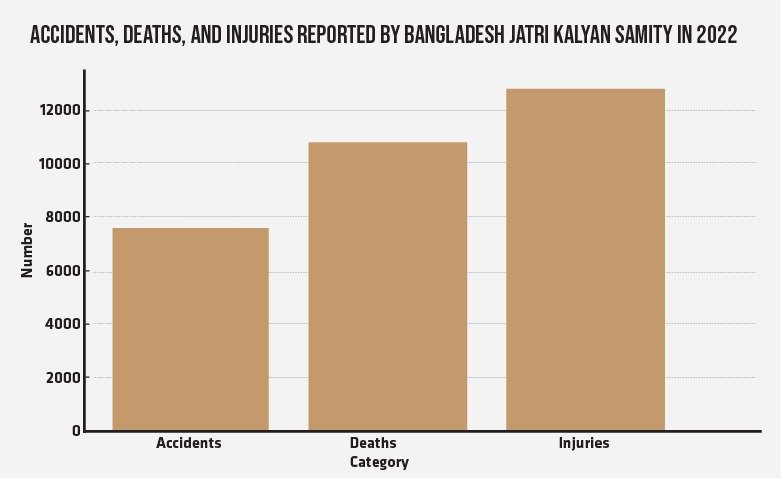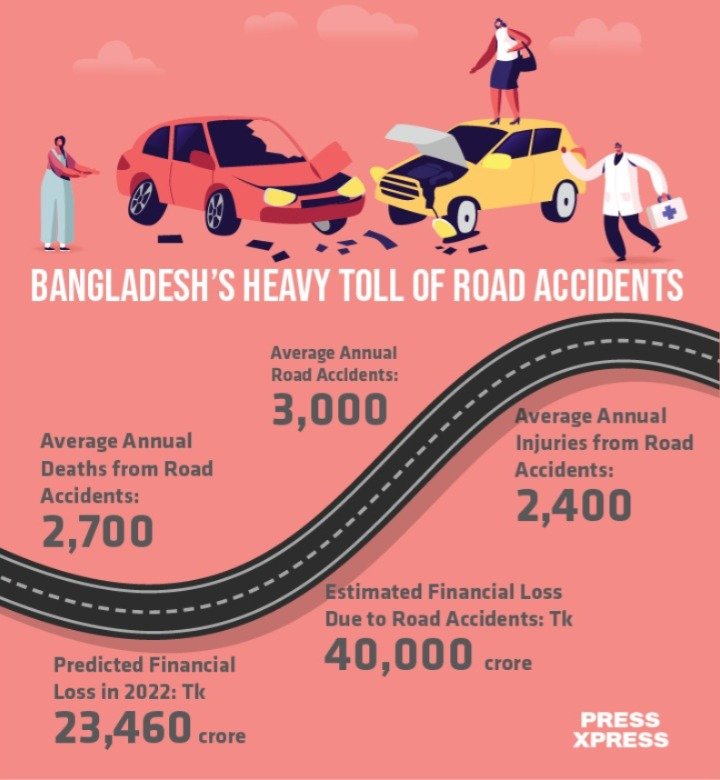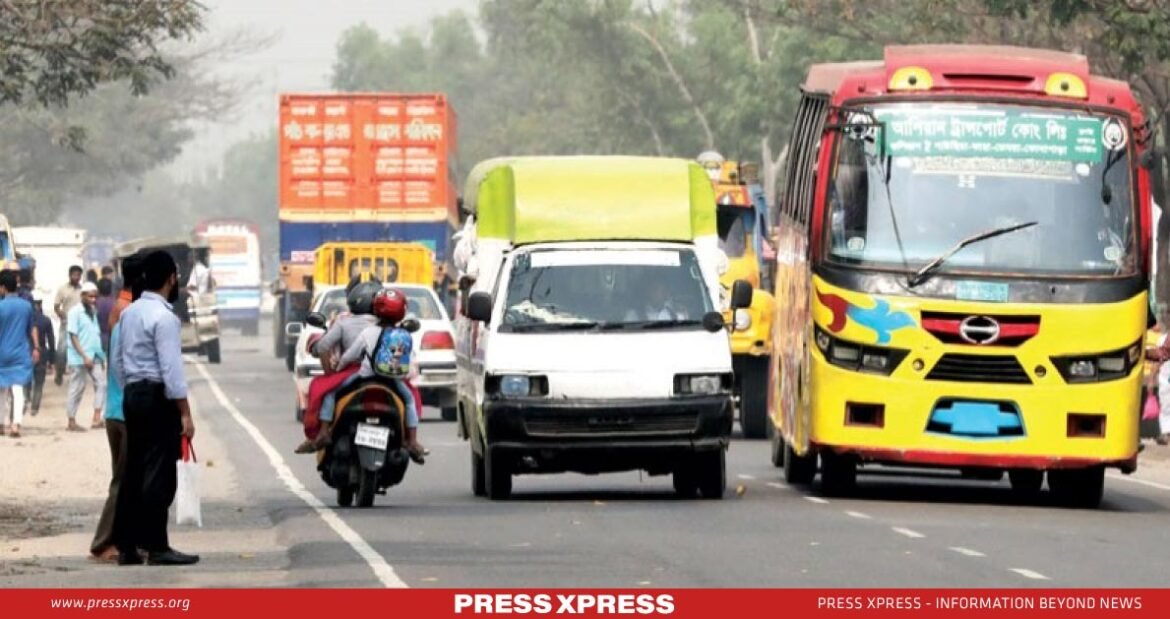Key Highlights:
- Bangladesh experiences an average of at least 3,000 road accidents annually
- In 2022, the Bangladesh Jatri Kalyan Samity reported a total of 10,858 deaths and 12,875 injuries from 7,617 accidents
- In 2022, 15% of traffic accidents in Bangladesh were due to poor road conditions
In Bangladesh, where the hustle of rickshaws meets the roar of buses, the implementation of road safety measures is a performance that demands both precision and time. Despite the country’s strides in economic growth, the road safety statistics paint a sobering picture.
You Can Also Read: ROAD SAFETY IN FOCUS AHEAD OF EID VACATION
According to recent data, implementing comprehensive road safety measures can take up to 2 years, involving intricate planning, infrastructural development, and stringent enforcement of traffic laws. With over 3,000 fatalities annually and countless injuries, the urgency for effective road safety protocols has never been more pronounced.
Prime Minister Sheikh Hasina issued a series of directives during a cabinet meeting on June 25, 2018, to enhance road safety and enforce traffic discipline across the country, aiming to reduce the number of accidents. Despite these government initiatives, several major accidents occurred, sparking nationwide outrage and protests demanding improved road safety measures.
Although the directives focus mainly on improving drivers’ ability to drive safely, transport owners argue that they cannot fully implement these measures without the government’s Public-Private Partnership (PPP) project.
The Human Fallout of Unruly Roadways
The current road safety situation in Bangladesh is causing significant distress among the general public. A World Bank report indicates that the mortality rate from traffic accidents decreased from 2005 to 2018. However, in 2019, this trend reversed due to the increasing number of vehicles, lack of awareness, and organized syndicates.
Despite a two-month suspension of all road transport following the COVID outbreak in 2020, police data reported 3,918 deaths and 3,826 injuries from 4,198 road crashes. In 2022, the Bangladesh Jatri Kalyan Samity reported a total of 10,858 deaths and 12,875 injuries from 7,617 accidents across roadways, railways, and waterways—the highest figure in the past 8 years. Road crash fatalities increased by 27.43% in 2022 compared to 2021.
The report revealed that 52.02% of accidents occurred on regional highways, 27.70% on national highways, and 11.88% on feeder roads. Additionally, these accidents frequently involved pedestrians, cyclists, and motorcyclists.

Counting the Economic Cost of Traffic Incidents
Bangladesh experiences an average of at least 3,000 road accidents annually, resulting in approximately 2,700 deaths and 2,400 injuries, according to data from the Accident Research Institute (ARI) of Bangladesh University of Engineering and Technology (BUET), based on police records.
The estimated financial loss due to road accidents in Bangladesh is around Tk 40,000 crore, equivalent to 2-3% of the GDP, with the predicted loss in 2022 being Tk 23,460 crore.
Beyond the financial impact, road accidents lead to the loss of lifelong physical abilities, damage to vehicles, roads, and other infrastructures, as well as materials and resources. These accidents also harm the environment, increase pollution, create social chaos, political unrest, and commotion, and exacerbate rule violations.

What’s Behind the Wheel of Death?
The Bangladesh Road Safety Foundation projected that 82% of traffic accidents in Bangladesh in 2022 was due to reckless driving. This contrasts with the global average of 18.2 road fatalities per 100,000 people, highlighting Bangladesh’s higher risk.
The Motor Vehicles Ordinance restricts transport drivers to 5 hours of continuous driving, with a mandatory half-hour break, and limits daily and weekly driving hours to 8 and 48, respectively, to prevent fatigue. However, due to long distances and traffic congestion, long-haul drivers often drive 10-14 hours per day, increasing accident risks.
In 2022, 15% of traffic accidents in Bangladesh were due to poor road conditions, resulting in 960 fatalities. Despite the Road Transport Act 2018 imposing stricter penalties, including a 5-year jail term and/or a fine of BDT 500,000 for fatal accidents—100 times higher than previous penalties—many drivers remain undeterred due to lax enforcement.
Many road users lack awareness of safety measures, leading to reckless driving, dangerous overtaking, and distractions like mobile phone usage. Other factors include poorly maintained roads, unfit vehicles, and insufficiently skilled drivers.
Currently, less than 10% of severely injured crash victims in Bangladesh are transported by ambulance to emergency care. Ambulance services are fragmented and uncoordinated, with no clear deployment policy. Private ambulances are costly, and most hospitals refuse to admit crash victims.
Bangladesh Road Safety Snapshot
| Factor | Percentage/Number | Description |
| Reckless driving | 82% | Percentage of traffic accidents in Bangladesh in 2022 |
| Poor road conditions | 15% | Percentage of traffic accidents in Bangladesh in 2022 |
| Fatalities due to poor roads | 960 | Number of fatalities due to poor road conditions in 2022 |
| Ambulance transportation | <10% | Percentage of severely injured crash victims transported by ambulance to emergency care in Bangladesh |
| Global road fatalities | 18.2 per 100,000 people | Global average of road fatalities per 100,000 people |
| Driving hours limit (daily) | 8 hours | Maximum daily driving hours allowed by Motor Vehicles Ordinance |
| Driving hours limit (weekly) | 48 hours | Maximum weekly driving hours allowed by Motor Vehicles Ordinance |
| Penalty for fatal accidents | BDT 500,000 fine and/or 5-year jail term | Penalties imposed by Road Transport Act 2018 for fatal accidents in Bangladesh |
| Percentage of accidents due to long-haul driving | 10-14 hours per day | Percentage of traffic accidents attributed to long-haul drivers exceeding driving hour limits |
A Spotlight on Bangladesh’s Efforts to Enhance Road Safety
Sustainable Development Goals (SDG) Targets 3.6 and 11.2 aimed to halve global road deaths and ensure universal access to safe transport in cities by 2020 (United Nations 2015). However, this goal was not met due to insufficient resources and actions.
In 2022, the World Bank approved $358 million to help Bangladesh improve road safety and reduce fatalities and injuries under the Road Safety Project on high-risk highways and district roads to achieve the SDGs on road safety by 2030. It will pilot comprehensive road safety measures on the N4 (Gazipur-Elenga) and N6 (Natore to Nawabganj) highways, aiming to reduce road traffic deaths by over 30%.
To enhance safety on highways and urban roads, the project will install road signs, dividers, footpaths, raised zebra crossings, speed breakers, and bus bays in Dhaka, Khulna, Rajshahi, Rangpur, and Mymensingh.
The government is launching a pilot project to use nanotechnology in road construction, aiming to implement the Sustainable Development Goals (SDGs) by 2030. This project will use ‘Acrylic Polymer’ to reduce road construction costs by at least 30% and provide safer roads than traditional bitumen.
Earlier, in June 2017, Bangladesh designated October 22 as National Safe Roads Day to raise public awareness.
Despite notable economic progress, road safety remains a pressing issue, highlighted by alarming accident statistics and significant human loss. Implementing comprehensive safety measures, though complex and time-consuming, is essential. The government’s intensified efforts, supported by rigorous directives, innovative projects, and collaboration with international bodies like the World Bank, offer a glimmer of hope. While the journey ahead is long, unwavering commitment and collective action can guide Bangladesh towards a future where every journey is safe.


